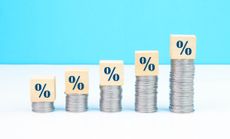What’s happening to your finances in April?
Big changes in April mean households will face higher taxes, bigger bills and increasing costs


April's set of dramatic changes to household finances are now in effect. The squeeze on personal finances will leave people on average £2,500 worse off this year, according to the Centre for Economics and Business Research.
National insurance has risen, the energy price cap increase has been applied to bills, income tax bands are frozen, council tax is up, rail fares have rocketed and inflation has hit 6.2%.
Shockingly, more than two-fifths (42%) of families with children living at home are expecting to take on additional debt to deal with soaring energy bills, according to a financial confidence tracker. It’s not just parents that are worried either ‒ around one in five (19%) of people without children at home think the energy costs crisis will push them into further debts.
Finance expert Lisa Conway-Hughes says. “As household bills are rocketing, I recommend doing a really detailed budget planner of what you are likely to spend throughout the year. And start to set aside money now as it starts to get warmer for those winter fuel bills.”
We explain what’s going up, and what you can do to prepare your finances.
1. The national insurance rise
The amount we pay in national insurance has increased by 1.25 percentage points. You’ll see it under your national insurance deductions, which have gone from 12% to 13.25%. Designed to help fund the NHS, someone earning £50,000 for example is paying an extra £505.
2. Energy price cap rises
The energy price cap ‒ which limits how much energy suppliers can charge on their default tariffs ‒ increased on 1 April.
Look After My Bills Newsletter
Get the best money-saving tips, tricks and deals sent straight to your inbox every week. Make sense of your money in partnership with The Money Edit.
It’s moved from £1,277 to £1,971 for typical households, which means a bill increase of an extra £693 per year on average.
It’s estimated that as a result of the increase, more than a quarter of households will be in fuel poverty ‒ defined as when more than 10% of your budget is spent on fuel bills ‒ according to the Resolution Foundation. The energy price cap rise means that many households, not just the poorest, will now find it a struggle to pay their bills each month. One Money Edit reader has resorted to using dehumidifiers to mitigate his energy costs.
One of the knock-on effects of the Ukraine crisis is that wholesale energy prices ‒ essentially what the suppliers pay for the energy we use ‒ have leapt upwards again, which means the UK may well face another big jump in energy prices when Ofgem, the energy regulator, reviews the price cap in August, ahead of changes that would take place in October.
Indeed, Ofgem has said it will update the price cap more regularly than every six months in “exceptional circumstances”.
We have 17 ideas to cut energy costs. Check to see if you are eligible for financial support for your energy costs from the government, local councils and providers. Households can also expect to receive a £200 discount applied to their electricity bill in October this year.
3. Rising train prices
Rail fares in England and Wales rose by 3.8% in March, the steepest increase since January 2013. The hike, which applies to regulated fares, will add more than £100 to the cost of many annual season tickets.
For example, it means commuters with an annual season ticket to travel between Tunbridge Wells and London will pay an extra £220, with their season ticket jumping from £5,046 to £5,248.
You can try to save money by working from home on certain days of the week - you won’t need a full season ticket this way. Alternatively, splitting your tickets, buying in advance or buying a railcard if you are eligible may be worth looking into.
4. Income tax thresholds frozen
Everybody enjoys a personal allowance, which is how much you can earn each year before having to pay income tax, and it currently stands at £12,570. You then have to earn a certain amount before you move into a higher income tax bracket ‒ for example, the higher rate income tax threshold sits at £50,720.
The government has decided to leave these thresholds as they are until 2026. This means that as many as 1.3 million workers will be dragged over the 40% higher-rate threshold within five years when they get a pay rise.
For example, anyone earning £48,800 who gets a 3% pay rise this year will be pushed into this 40% higher-rate tax bracket. A lower earner on £12,200 could be pushed into the 20% basic-rate tax bracket through a similarly-sized payrise.
You can take action here and reduce your tax bill with a bit of financial planning, in particular by using pension contributions and double-checking your expenses for your tax return.
“The beginning of the tax year is always a great time to take stock of your money,” says Conway-Hughes. “Are you paying enough into your pension? Do you have money that you can invest into a stocks and shares ISA this year?”
5. Dividend tax rate increases
As part of new social care measures, the Treasury has also increased the dividend tax by 1.25%.
Basic-rate taxpayers now pay 8.75% tax on dividends rather than 7.5%, higher-rate taxpayers pay 33.75% instead of 32.5%, while additional rate taxpayers now pay 39.35% rather than 38.1%.
Taxpayers will still be allowed to earn £2,000 of dividends tax-free, but anything above that will be taxable.
This change affects company directors who draw an income through dividends. For example, if you are a small business owner who operates as a limited company, and pay yourself £50,000 in dividends, you now pay an extra £443 a year. A business owner earning £80,000 in dividends now pays an extra £649 a year.
Investors who haven’t put income-producing investments in an ISA or SIPP and receive £20,000 in dividends now pay an extra £225 tax.
6. Pensions lifetime allowance frozen
The pensions lifetime allowance - that’s the amount you can save into a pension and receive tax benefits - has been frozen at £1,073,100 since 2020.
While this might sound like a relatively minor change aimed at the wealthiest in society, a significant section of middle Britain has now been dragged into its net. For example, high-earning doctors and consultants in the NHS who benefit from generous defined benefit pensions are hit by this measure.
The impact will depend in part on what happens to inflation over the next four years. Freezing the allowance while inflation rises sharply actually equates to cutting it in real terms.
7. Capital Gains Tax allowance frozen
The Capital Gains Tax (CGT) allowance is also to be frozen at £12,300 until 2026. CGT is payable when you sell off an asset at a profit; people who are probably most at risk from higher CGT bills are landlords and second property owners, as houses can’t be sold in chunks to realise £12,300 of profit every year, nor can they be put in an ISA.
Capital Gains Tax is often viewed as an avoidable tax, as a result of the sizeable gains that can be made each year tax-free, alongside the £20,000 ISA allowance which protects investments from CGT.
8. Netflix subscription
Netflix's rise in the price of its different packages came into effect for new subscribers in March and for existing subscribers in April.
All its 14 million subscribers in the UK are affected.
The price of its basic package - which allows viewers to watch only one screen at a time and download to one device - has gone up by £1 a month, from £5.99 to £6.99. Its most popular package, which offers simultaneous viewing on two screens, HD and the ability to download shows and films to two devices, has risen to £10.99 a month.
Meanwhile, the cost of the premium plan, which allows Netflix to be watched on up to four different screens at a time and downloads to up to four devices, has increased by £2 a month to £15.99.
What you can do to mitigate so many price rises
Almost half of people in the UK consider the rising cost of living to be their biggest money concern, according to Aldermore Bank’s latest savings tracker.
A third have not made plans to manage the rise in living costs and one in five are worried about not having adequate emergency savings in case of unexpected expenses.
To tackle the oncoming changes, you will need to pull out all the stops to keep as much of your money for yourself as possible.
Becky O’Connor, head of savings at investment platform interactive investor, says: “What we are looking at now is the need to reduce consumption in order to reduce outgoings, not merely switch to cheaper providers. We will have to get used to buying less, eating out less and sadly again, holidaying less. Grand design projects that once seemed achievable might now look like the height of luxury.”
Her primary advice is to look at what spending you can cancel completely rather than just find cheaper. “It might seem drastic – it also might make you feel like you are not doing enough to help keep the economy moving and thriving. But if you don’t make substantial changes now, then in a few months, you could end up experiencing even more difficulty, once rising energy costs really begin to bite,” she says. “Don’t just cut back – hack back.”
There are many ways to keep trimming your outgoings even if you have already started to do so.
For example, you might want to consider remortgaging. As soon as your mortgage deal ends, you’re automatically put on your lender’s standard variable rate (SVR), which is invariably higher than your current rate. You may be able to save around £200 a month just by making a straightforward switch.
It may also be worth asking for a pay rise, especially if you haven’t had one in a while. Assume your employer or clients won’t say no to even a small increase. A small rise may not seem like much, but it will go some way to covering the rise in your living expenses.
Moira O’Neill, head of personal finance at interactive investor, also suggests people use their annual tax allowances for ISAs and pensions. “You can have two gos at this in April if you haven’t used them before. Move investments to an ISA and consider taking one out if you haven’t already. Inside a stocks and shares ISA your investments grow free from Capital Gains Tax and income tax. Dividends are also tax-free in an ISA.”
If you’re a higher rate taxpayer, or become one soon, a pension contribution is another good way to reduce your tax bill - but only if you can afford it.
For each £800 you put in, the government adds £200 to your pension, even if you’re a basic rate or non-taxpayer, up to certain limits. Higher rate taxpayers can then also knock a further £200 off their tax bill, which they would normally pay when they complete their tax return.
The net effect is you get £1,000 in your pension, and as a higher rate taxpayer it only costs you £600. Your investment growth and income are then tax-free inside the pension, and you can take 25% of your total pot as a tax-free lump sum at retirement.
Katie is staff writer at The Money Edit. She was the former staff writer at The Times and The Sunday Times. Her experience includes writing about personal finance, culture, travel and interviews celebrities. Her investigative work on financial abuse resulted in a number of mortgage prisoners being set free - and a nomination for the Best Personal Finance Story of the Year in the Headlinemoney awards 2021.
-
 Three energy firms pay £8m in switching compensation - has your provider paid out?
Three energy firms pay £8m in switching compensation - has your provider paid out?More than 100,000 customers have received compensation after changing providers, but is now a good time to switch energy suppliers?
By Tom Higgins Published
-
 Save £300 on your supermarket shop with cashback accounts
Save £300 on your supermarket shop with cashback accountsBanks, credit card companies and cashback sites are all offering cashback on your supermarket shop, but can you use them all to max out your savings?
By Vaishali Varu Published
-
 Save on petrol: how to save 5p off a litre of fuel at Morrisons
Save on petrol: how to save 5p off a litre of fuel at MorrisonsPetrol prices may have been falling since last summer but every penny counts at the pump. Here’s how to save 5p a litre at Morrisons for a limited time
By Sue Hayward Published
-
 Morrisons relaunches discount scheme with cheaper prices for loyal shoppers
Morrisons relaunches discount scheme with cheaper prices for loyal shoppersMorrisons is the latest supermarket to revamp prices and offers for its loyalty scheme members
By John Fitzsimons Published
-
 Coronation freebies and discounts: what’s up for grabs
Coronation freebies and discounts: what’s up for grabsFrom free railcards and holiday giveaways to discounts off food, we highlight the special offers launched to mark the coronation of King Charles III
By Ruth Emery Last updated
-
 8 ways to get interest-free money if you’re struggling
8 ways to get interest-free money if you’re strugglingHere are 8 clever ways to get interest-free income if you’re struggling with the rising cost of living
By Vaishali Varu Last updated
-
 Best birthday freebies and discounts
Best birthday freebies and discountsEnjoy your special day with these birthday discounts and freebies - we highlight 22 of the best offers
By Vaishali Varu Published
-
 Festival ticket scam warnings – how to protect yourself
Festival ticket scam warnings – how to protect yourselfConcert ticket scams have rocketed by more than 500% over the past year, while festival fraud has more than doubled. Here’s how to keep yourself safe ahead of the festival season.
By Tom Higgins Published
-
 Co-op Member Prices: Supermarket unveils discount scheme for loyal shoppers
Co-op Member Prices: Supermarket unveils discount scheme for loyal shoppersNew Co-op scheme means reduced prices for shoppers who join the co-operative. How much does it cost to join, and how does it compare to similar schemes run by Sainsbury’s and Tesco?
By John Fitzsimons Published
-
 Emergency alert test: what to expect and how to avoid being scammed
Emergency alert test: what to expect and how to avoid being scammedWe tell you everything you need to know about the UK’s first emergency alert test, which takes place this Sunday
By Vaishali Varu Published